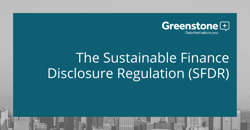The Sustainable Finance Disclosure Regulation (SFDR)
 The new Sustainable Finance Disclosure Regulation (SFDR) has made a notable entry into the sustainable finance sphere. This new regulation, which formally came into force on 10 March 2021, requires all financial market participants in the European Union (EU) to report Environment, Social and Governance (ESG) disclosures, with additional requirements for products that promote ESG characteristics or that have sustainable investment objectives.
The new Sustainable Finance Disclosure Regulation (SFDR) has made a notable entry into the sustainable finance sphere. This new regulation, which formally came into force on 10 March 2021, requires all financial market participants in the European Union (EU) to report Environment, Social and Governance (ESG) disclosures, with additional requirements for products that promote ESG characteristics or that have sustainable investment objectives.
Even though it’s early days in terms of reporting deadlines for SFDR, there is a lot of discussion around what it means for financial firms and ESG reporting. Our team of industry experts has written the following blog, addressing the key points and meaningful deadlines of the regulation that businesses should be aware of.
What is SFDR?
SFDR is a part of an extensive ESG-based set of regulations implemented by the EU. The principal aim of this legislation is to redirect capital flow towards sustainable finance. Another key objective of SFDR is to prevent ‘greenwashing’ and provide transparency on sustainability within the financial market to ensure that financial market participants (FMPs) are able to embed sustainability into decision making.
Transparency is a vital aspect of this legislation, as it focusses on how providers of financial products manage and reduce sustainability risks. There are specifications at both entity and product levels. Specifically, the SFDR establishes and implements transparency criteria for financial commodity characteristics, allowing them to be compared based on their sustainability level.
Who does SFDR apply to?
The SFDR regulation applies to FMPs such as investment firms, pension funds, asset managers, insurance companies, banks, venture capital funds, credit institutions offering portfolio management, or financial advisors. FMPs with fewer than 500 employees are not captured under the SFDR (although under the ‘comply-or-explain’ principle they are obligated to explain why).
What information needs to be disclosed under SFDR?
FMPs in the EU are required to disclose information on both their sustainability practices (entity-level) and their financial products (product-level). If these FMPs’ financial products make sustainable investments, the manager is required to demonstrate how those investments abide by the regulation's "do no significant harm" policy.
FMPs need to also report on their Principal Adverse Impacts (PAIs) at both an entity- and a product-level. There are 50 PAI sustainability indicators (some mandatory and some voluntary) covering a range of ESG issues including greenhouse gas emissions, human rights and waste management. The regulation guidance regarding the timing of the reporting requirements on these PAIs is complex, which is why we continue to see different interpretations in the market but it seems that entity-level reporting framework for PAIs will begin as a "comply or explain" requirement, shifting to "comply" for large FMPs on June 30, 2021.
Best practices on how to adapt to the new regulation
When approaching the SFDR regulation, one of the initial steps is establishing which sections are relevant to your company and products. Then we suggest the following steps:
- Get to know the sustainability efforts and position of your business.
- Perform a gap analysis and risk assessment based on current ESG data, activities, and regulations (this will help you discover weak points and vulnerabilities).
- Establish what steps the company needs to take to ensure full compliance with SFDR.
- Begin building an SFDR approach tailored to your business.
- Develop a long-term strategy for implementing the sustainability risk policy, due diligence policy, remuneration policy, and communication tactics.
Key dates
June 30 2021: The date by which a large financial market participant can start to report.
Dec 31 2021: End of 1st reference period
January 1 2022: First deadline for asset managers to submit annual product-level ESG disclosures in line with the SFDR.
Dec 31 2022: End of 2nd reference period (with Principal Adverse Impacts)
June 30 2023: Details of the assessment of PAIs for the 1st reference period must be reported.
Dec 31 2023: End of 3rd reference period
June 30 2024: The FMP must complete disclosure with a historical (year-on-year) comparison.









